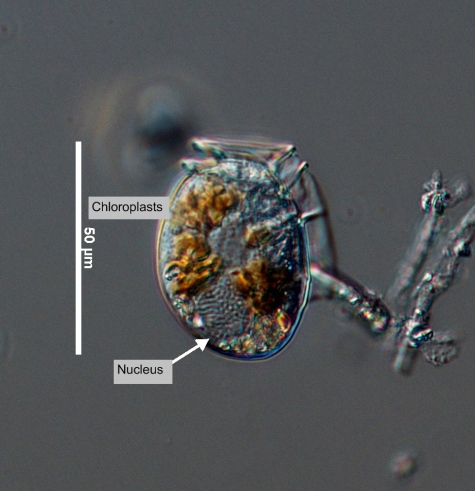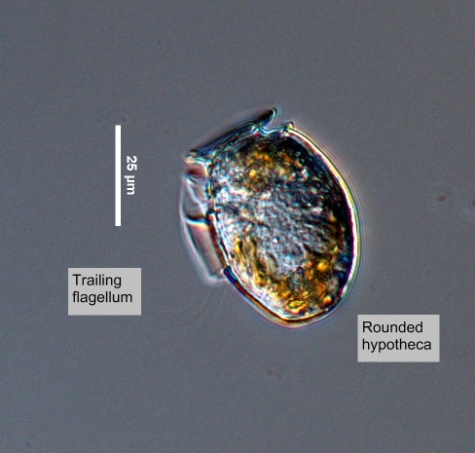




|
Synonym(s)
Dinophysis lachmanii Paulsen 1949
Dinophysis boehmi Paulsen 1949
Dinophysis lachmanii Solum 1962
Dinophysis skagii Paulsen 1949
Dinophysis ellipsoides Kofoid 1907
(Kraberg et al. 2010)
Classification
(Guiry and Guiry 2011)
Lifestyle
Description
Lateral
Relating to a side-to-side direction.
lateral view, cells are clamshell, oval or elliptical in shape, with a crown on top, a wing or fin at the side, and a round ClosePosterior
The back end of a cell. Opposite of anterior.
posterior. Posterior profile is round, sometimes with small CloseVentral
Relating to the underside of an organism; abdominal.
ventrally placed CloseAntapical
Referring to the most posterior point of a cell. The opposite of apical.
antapical protuberances (Dodge 1982). Left CloseSulcal list (left and right)
In dinokont dinoflagellates, a well-defined groove on the ventral surface that is supported by ribs.
sulcal list is well developed and extends beyond the midpoint of the cell. Cells have three CloseSulcus
"In dinokont dinoflagellates, the longitudinal area on the ventral surface that forms a furrow or depression and houses the longitudinal (trailing) flagellum" (Horner 2002).
sulcal CloseRibs
Features that provide support to other structures in the cell.
ribs, with the third and longest pointing to the posterior (Kraberg et al. 2010). Cells have several large reddish-brown chloroplast that are associated with a posteriorly placed ClosePyrenoid
Any of various protein granules that can be found in the chloroplast of some algae species. It is associated with the production of starch.
pyrenoid. Cells have a centrally located CloseNucleus (plural: nuclei)
In eukaryotic cells, a membrane-bound organelle that contains the cell's genetic information; the nucleus controls the activities of the cell by controlling gene expression.
nucleus and a low CloseEpitheca
In thecate dinoflagellates, the anterior part of a dinokont cell above the cingulum. The equivalent of epicone for naked dinoflagellates.
epitheca that does not extend beyond CloseCingulum
(dinoflagellates) "In dinokont dinoflagellates, a furrow encircling the cell one or many times" (Horner 2002). It is also known as the girdle or transverse groove and may be located at, above, or below the midpoint of the cell with the left and right ends meeting or displaced form one another (Horner 2002). In diatoms, this term describes the collective elements of a diatom girdle: "The cingulum is made up of delicate silica bands that join the two valves of a frustule. Most diatoms possess a cingulum, although some may not" (Spaulding et al. 2010).
cingular list (Kraberg et al. 2010).Measurements
Diameter: 38 - 58 μm
(Horner 2002)
Similar species
Hypotheca
In thecate dinoflagellates, the posterior part of a dinokont cell above the cingulum. The equivalent of a hypocone for naked dinoflagellates.
hypotheca of Dinophysis acuminata has sides that are round or oval-shaped, unlike the straight side of Dinophysis acuta.Harmful effects
Lipophilic
Having the ability to combine with or dissolve lipids.
lipophilic toxins (okadaic acid derivatives and pectenotoxins) causing diarrhetic shellfish poisoning (DSP; Escalera et al. 2010). Toxin production is affected by light intensity. In a lab experiment, highest toxin production occurred at light levels below 65 μmol photons m-2 s-1. No toxins were produced in dark treatments or above 65 μmol photons m-2 s-1 (Tong et al. 2010).Habitat
Distribution
Cosmopolitan
Widely distributed; occurring in many parts in the world.
Cosmopolitan in warm to cold temperate waters worldwide (Steidinger and Tangen 1997).Growth conditions
Environmental Ranges
Temperature range (°C): -1.203 - 21.917
Nitrate (μmol L-1): 0.738 - 10.982
Salinity: 27.165 - 37.775
Oxygen (mL L-1): 5.041 - 8.968
Phosphate (μmol L-1): 0.097 - 0.677
Close
Silicic acid
A general term to describe chemical compounds containing silicon, oxygen and hydrogen with a general formula of [SiOx(OH)4-2x]n. Diatoms polymerize silicic acid into biogenic silica to form their frustules (Azam and Chisholm 1976).
Silicate (μmol L-1): 1.190 - 39.813(EOL 2012)
Bloom characteristics
Stratification
The development of distinct non-mixing layers in the water column resulting from a steep gradient in density, which is caused by differences in temperature and/or salinity.
stratification (Miota et al. 2006).References
Dodge, J. D. 1982. Marine Dinoflagellates of British Isles. Her Majesty's Stationary Office, London, UK. 303.
Encylopedia of Life (EOL) 2012. Dinophysis acuminata Claperede and Lachman 1859. http://eol.org/pages/901407/details. Accessed 19 Mar 2012.
Escalera, L., Reguera, B., Miota, T., Pazos, Y. and Cerejo, M. 2010. Bloom dynamics of Dinophysis acuta in an upwelling system: in situ growth versus transport. Harmful Algae. 9(3): 312-322..
Guiry, M. D. and Guiry, G .M. 2011. Dinophysis acuminata Claperede and Lachman 1859 http://www.algaebase.org/search/species/detail/?species_id=52217. Accessed 05 May 2011.
Horner, R. A. 2002. A Taxonomic Guide To Some Common Phytoplankton. Biopress Limited, Dorset Press, Dorchester, UK. 200.
Miota, M. T., Gonçalves, L. S., Oliveira, P. B. and Falcão, M. 2006. A bloom of Dinophysis acuta in a thin layer off north-west Portugal. African Journal of Marine Science. 28(2): 265 -269.
Reguera, B., Bravo, I. and Fraga, S. 1995. Autoecology and some life history stages of Dinophysis acuta Ehrenberg. Journal of Planktonic Research. 17(5): 999-1015.
Steidinger, K. A. and Tangen, K. 1997. Dinoflagellates. In: Tomas, C. R. (ed.) Identifying Marine Phytoplankton. Academic Press, Inc., San Diego. 429.
Tong, M., Kulis, D. M., Fux, E., Smith, J. L., Hess, P. 2010. The effects of growth phase and light intensity on toxin production by Dinophysis acuminata from the northeastern United States. Harmful Algae. 10(3): 254-264.
